
 |
Tea Clipper |
 |
| from TeaAntiques.com | ||
| Edition Thirty |
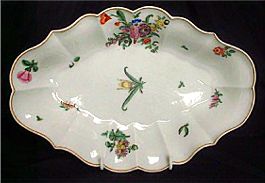
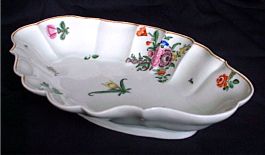 A magnificent and rare First Period Worcester lozenge shaped
dessert dish, exquisitely painted with decorative flower sprays and sprigs in beautiful coloured
enamels. This wonderful dish was made at the famous Worcester factory, c1770.
A magnificent and rare First Period Worcester lozenge shaped
dessert dish, exquisitely painted with decorative flower sprays and sprigs in beautiful coloured
enamels. This wonderful dish was made at the famous Worcester factory, c1770.
The inside of the dish is most beautifully and skilfully painted with scattered flowers. There is a main floral spray on one side of the dish, this having bright red, blue, pink, yellow and purple flowers amongst brilliant green foliage. The detail of these painted flowers and foliage is wonderful.
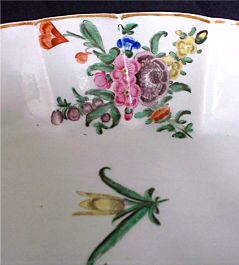
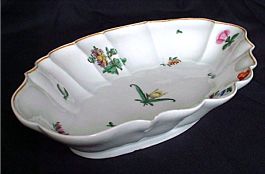 Scattered around the bowl of the dish are separate single flower
sprigs of various types and colours, much in the way of the Meissen flower
decoration of the period. These flower sprigs include pink and orange hanging
bell shaped flowers, orange rose and pink trumpet shaped flowers. Interspersed
are foliage sprigs in green giving a delightfully well balanced decorative dish.
Scattered around the bowl of the dish are separate single flower
sprigs of various types and colours, much in the way of the Meissen flower
decoration of the period. These flower sprigs include pink and orange hanging
bell shaped flowers, orange rose and pink trumpet shaped flowers. Interspersed
are foliage sprigs in green giving a delightfully well balanced decorative dish.
This is a rare and extremely fine quality First Period Worcester dessert dish c1770, a dish produced in the golden years of the famous Worcester factory. It is exquisitely decorated with charming and colourful flower decoration, a fine example for the collector of the best of the Worcester porcelain from the eighteenth century.
More details of this item and other tea related antiques can be found by visiting my web site at www.TeaAntiques.com.
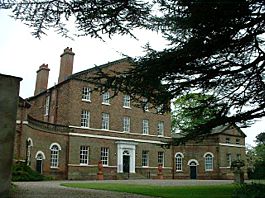 On approaching Sutton Park house from the front it appears
rather like a small eighteenth century gentleman’s country house or a country
vicarage, but how wrong this impression is. This is in fact a most beautiful
house, rather like a very grand country house in miniature, with the central
block flanked by two forward projected wings which are connected to the main
house by curved walls. This elevation of the house, whilst being rather stark is
a very fine and extremely well proportioned piece of Georgian architecture,
dating from 1750-1755. The architect responsible for this house design is
believed to be Thomas Atkinson.
On approaching Sutton Park house from the front it appears
rather like a small eighteenth century gentleman’s country house or a country
vicarage, but how wrong this impression is. This is in fact a most beautiful
house, rather like a very grand country house in miniature, with the central
block flanked by two forward projected wings which are connected to the main
house by curved walls. This elevation of the house, whilst being rather stark is
a very fine and extremely well proportioned piece of Georgian architecture,
dating from 1750-1755. The architect responsible for this house design is
believed to be Thomas Atkinson.
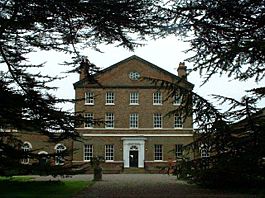 The house is owned today by Sir Reginald and Lady Sheffield
and is a lived-in house, which is evident to the visitor by the very much lived-in and interior layout of the rooms - a very comfortable house. The Sheffield
family moved to this house in 1963, a family with long ancestral connections
with Yorkshire and North Lincolnshire.
The house is owned today by Sir Reginald and Lady Sheffield
and is a lived-in house, which is evident to the visitor by the very much lived-in and interior layout of the rooms - a very comfortable house. The Sheffield
family moved to this house in 1963, a family with long ancestral connections
with Yorkshire and North Lincolnshire.
The house has an interesting history and connection to what is today Buckingham Palace, London. John Sheffield, who died in 1721, had been created 1st Duke of Buckingham & Normandy. As well as estates in North Yorkshire and lands in Lincolnshire, he had a London house, then called Buckingham House. Later, in 1762 Buckingham House was sold to the Crown and is what we now know as Buckingham Place - today the Palace has been enlarged around the original Buckingham House. So it is his descendants who bought and now own Sutton Park.
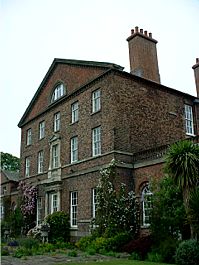
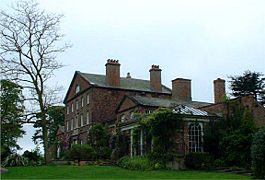 Entering the front door and into the Entrance Hall
confirms that this is no ordinary country house, but one with very fine and
rather grand interiors. Hung on the wall is a picture of Buckingham House as it was
in the time of John Sheffield and below which is a large Lacquered Japanese
Chest from Buckingham House. Indeed, in other rooms of the house there are other
items of exquisite furniture from the Buckingham House collection.
Entering the front door and into the Entrance Hall
confirms that this is no ordinary country house, but one with very fine and
rather grand interiors. Hung on the wall is a picture of Buckingham House as it was
in the time of John Sheffield and below which is a large Lacquered Japanese
Chest from Buckingham House. Indeed, in other rooms of the house there are other
items of exquisite furniture from the Buckingham House collection.
To the right of the Entrance Hall is a small room called the Porcelain Room, not difficult to see why! This simply but elegantly furnished room contains cabinets and chimney alcoves full of the very best eighteenth century porcelain that you could wish to see, including pieces form the famous Derby, Meissen, Worcester, Sèvres and Bow factories.
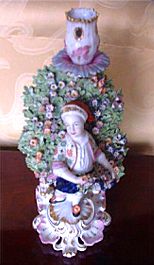
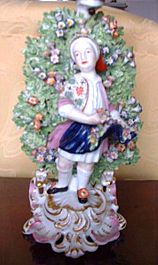 In the cabinet are some very magnificent Derby figures
representing the then four continents of the world. But an item that is not just
rare, but unique, is a most unusual teapot moulded in the form of a charming
Monkey, made in the Meissen factory c1740-45. The main body of the teapot is one
large Monkey, the handle and spout are formed by two further Monkeys. It is
quite amazing, the quality of the moulding and fine painting and brilliant
colours are truly a magnificent test to the skills of Kaendler who made this
delightful teapot at the Meissen factory.
In the cabinet are some very magnificent Derby figures
representing the then four continents of the world. But an item that is not just
rare, but unique, is a most unusual teapot moulded in the form of a charming
Monkey, made in the Meissen factory c1740-45. The main body of the teapot is one
large Monkey, the handle and spout are formed by two further Monkeys. It is
quite amazing, the quality of the moulding and fine painting and brilliant
colours are truly a magnificent test to the skills of Kaendler who made this
delightful teapot at the Meissen factory.
The Derby figure candlestick shown here is taken from my own collection, but shows the type of Derby figures that may be seen and enjoyed at Sutton park.
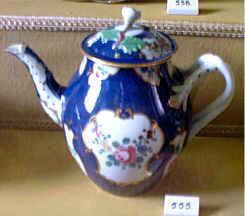
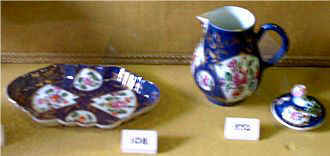 The alcoves either side of the fire place also hold items
of great interest to the lover of fine eighteenth century porcelain. In the left
alcove there is a large selection of ‘First’ or ‘Dr Wall’ Period Worcester. Most
are in the dark gros-blue scaled ground with panels painted with flowers etc.
(These examples shown here are in fact from the Ashmolean museum, Oxford). The alcove to the right of the fireplace has five shelves, each containing
porcelain from different factories. Working from the top are pieces by Chelsea,
Bow, Sèvres and Meissen. One of the most fascinating for me was a set of very
small cups with delicate handles, rather like teacups for a dolls house, but
these were standing on their original porcelain tray shaped like a leaf with the
handle formed by the leaf stalk-most unusual. This set were beautifully
decorated with hand painted sprays of flowers, a design associated with Meissen
decoration. The guide in the room informed me that these cups were designed for
herb or mint tea, rather than the conventional teas we know today. The two
images of a Worcester scale blue and floral decorated plate, are taken from my
own collection of Worcester porcelain.
The alcoves either side of the fire place also hold items
of great interest to the lover of fine eighteenth century porcelain. In the left
alcove there is a large selection of ‘First’ or ‘Dr Wall’ Period Worcester. Most
are in the dark gros-blue scaled ground with panels painted with flowers etc.
(These examples shown here are in fact from the Ashmolean museum, Oxford). The alcove to the right of the fireplace has five shelves, each containing
porcelain from different factories. Working from the top are pieces by Chelsea,
Bow, Sèvres and Meissen. One of the most fascinating for me was a set of very
small cups with delicate handles, rather like teacups for a dolls house, but
these were standing on their original porcelain tray shaped like a leaf with the
handle formed by the leaf stalk-most unusual. This set were beautifully
decorated with hand painted sprays of flowers, a design associated with Meissen
decoration. The guide in the room informed me that these cups were designed for
herb or mint tea, rather than the conventional teas we know today. The two
images of a Worcester scale blue and floral decorated plate, are taken from my
own collection of Worcester porcelain.
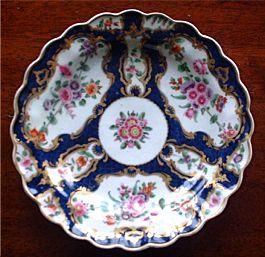
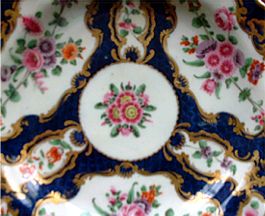
As if all this wonderful porcelain was not enough to behold, there is a delightful chandelier hanging in the room made from porcelain too. It is a magnificent with pierced porcelain body from which come six arms, each arm holding three candles. There are further decorative embellishments in the form of bunches of flowers moulded in porcelain and very striking in all their colourful glory. Then, to cap it all, there are figures and birds sat around the Chandelier - quite amazing and so delicate. This stunning chandelier was believed to have been made and painted in the Chelsea Derby factory in 1770-84, this copying the style of Meissen.
Leaving the Porcelain Room other rooms on the ground floor include the Library, Morning Room, Boudoir, Chinese Drawing Room, Dining Room, and Tea Room!
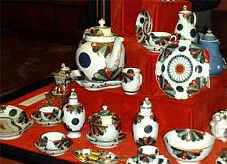 The Tea Room was a curious room, the walls and doors
painted to represent Tortoiseshell, rather heavy in appearance, but unusual. The
walls are hung round with a large collection of Imari plates exported from Japan
to this country c1720-30. It was from such Imari designs in red, blue and gold
that gave the inspiration to the famous English manufacturers to produce their
own versions. Factories such as Minton, Spode and Derby were such factories each
with their own interpretations. I could not find out why this room was called
the ‘Tea Room’!
The Tea Room was a curious room, the walls and doors
painted to represent Tortoiseshell, rather heavy in appearance, but unusual. The
walls are hung round with a large collection of Imari plates exported from Japan
to this country c1720-30. It was from such Imari designs in red, blue and gold
that gave the inspiration to the famous English manufacturers to produce their
own versions. Factories such as Minton, Spode and Derby were such factories each
with their own interpretations. I could not find out why this room was called
the ‘Tea Room’!
The items of Worcester tea wares in the 'Imari' style shown here are from the Victoria Gallery in Bath.
One of my favourite rooms in the house was the Boudoir, a very light and rather feminine looking room, decorated in a pastel green and having views out over the beautiful gardens and parkland beyond. Comfortably furnished with cosy sofas and dotted around with fine French furniture, including a very pretty desk. The room has a delightful glass Chandelier, sparkling from the light which pours into this room. This would be a most relaxing and delightful room in which to enjoy afternoon tea, (so why is this not called the ‘Tea Room’?)
The Chinese Drawing Room is hung with hand painted Chinese wall paper, green ground with exotic birds flying around the trees and flowers. Amazingly, this beautiful wallpaper dates from c1800, its colours remaining very vivid. An item of furniture worthy of note in this lovely room, is a stunning Queen Anne walnut bureau-bookcase which was originally from Buckingham House. It has a very handsome fitted interior to the top portion with pigeon holes and many small, intricately shaped drawers.
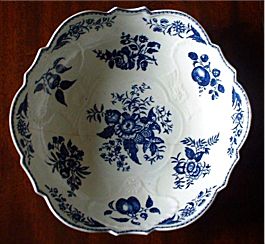
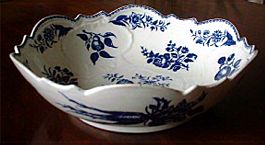 The Dining Room was relocated in one of the extended wings
of the house, the original dining room in the main part of the house was
considered too small and is now the Morning Room. The present Dining Room was
created by knocking four small rooms into one. It now provides a good size
dining room, decorated in a custard yellow colour and lit by a charming
Waterford crystal chandelier. At one end of the room are two large alcoves which
contain an array of ‘Dr Wall’ Period Worcester. Much of this porcelain is of the
Blue transfer printed style, with designs such as ‘the Three Cones’ etc. Pieces
include teapots, coffee pots, jugs, plates and bowls. The blue and white of this
charming porcelain compliment the yellow walls beautifully. The example shown
here is taken from my own collection of blue and white First period Worcester.
The Dining Room was relocated in one of the extended wings
of the house, the original dining room in the main part of the house was
considered too small and is now the Morning Room. The present Dining Room was
created by knocking four small rooms into one. It now provides a good size
dining room, decorated in a custard yellow colour and lit by a charming
Waterford crystal chandelier. At one end of the room are two large alcoves which
contain an array of ‘Dr Wall’ Period Worcester. Much of this porcelain is of the
Blue transfer printed style, with designs such as ‘the Three Cones’ etc. Pieces
include teapots, coffee pots, jugs, plates and bowls. The blue and white of this
charming porcelain compliment the yellow walls beautifully. The example shown
here is taken from my own collection of blue and white First period Worcester.
Upstairs, there are a few bedrooms open to the visitor, each delightfully furnished and look very comfortable-even the Red Bedroom which contains a grand eighteenth century four poster bed the frame of which is made of Coromandel wood.
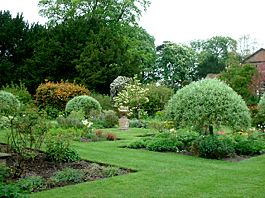
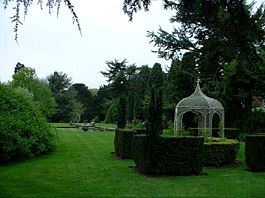 Not only is Sutton Park a most beautiful little treasure
trove, the gardens are equally delightful. At the back of the house is a terrace
and formal gardens, with well planted flower beds and decorative pond. Beyond
the formal garden are park lands belonging to the house and through which the
visitor can stroll.
Not only is Sutton Park a most beautiful little treasure
trove, the gardens are equally delightful. At the back of the house is a terrace
and formal gardens, with well planted flower beds and decorative pond. Beyond
the formal garden are park lands belonging to the house and through which the
visitor can stroll.
Before leaving, I took tea in their tea room (not the one in the house but in one of the out-buildings!) I noticed a little sign up stating ‘The best Lemon Cake in the country’. Well, with that acclaim I just had to try it and I must say it was certainly a delicious Lemon sponge cake. It was extremely light textured and seemed to melt in the mouth. The two layers of Lemon sponge were filled with a zesty Lemon curd and butter cream and the top of the cake had a ‘zingy’ Lemon water icing. Certainly worth a try and went down well with a pot of Lapsang Souchong tea.
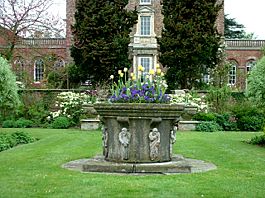
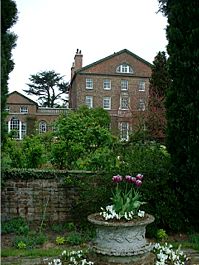
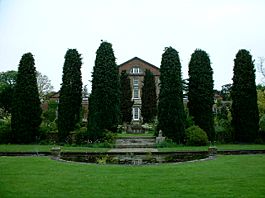
Although comparatively small, Sutton Park has much to offer and is a charming house that I would recommend as well worth a visit-particularly if you have an interest in rare and very fine eighteenth century porcelain. I hope that you enjoy a visit there sometime.
Sutton Park,
Sutton-on-the-Forest,
York, YO61 1DP
Telephone: 01347 810249/811239
Website:
www.statelyhome.co.uk
Map:
Click here - map courtesy of
www.streetmap.co.uk.
Opening times for 2002:
Every Sunday and Wednesday from 1st April - 30th
September. Plus all Bank Holiday Mondays.
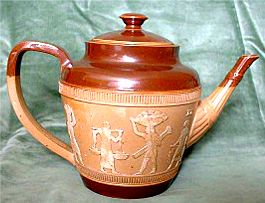
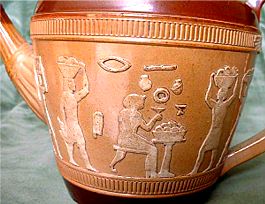 I recently discovered this wonderful Doulton stoneware teapot, which depicts
some ancient Egyptians making offerings to their gods and Pharaoh. This teapot
was made at the famous Doulton factory situated in Lambeth, London, on the
opposite side of the River Thames to, and in view of, the Houses of Parliament.
The factory building is still there, but no longer that of the Doulton factory,
which ceased manufacture from there in 1952. Made around 1920's after the
discovery of Tutankhamen's tomb and treasures by Howard Carter in 1922, this
teapot shows the mania for the Egyptian style that followed Tutankhamen's discovery.
I recently discovered this wonderful Doulton stoneware teapot, which depicts
some ancient Egyptians making offerings to their gods and Pharaoh. This teapot
was made at the famous Doulton factory situated in Lambeth, London, on the
opposite side of the River Thames to, and in view of, the Houses of Parliament.
The factory building is still there, but no longer that of the Doulton factory,
which ceased manufacture from there in 1952. Made around 1920's after the
discovery of Tutankhamen's tomb and treasures by Howard Carter in 1922, this
teapot shows the mania for the Egyptian style that followed Tutankhamen's discovery.
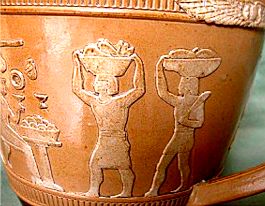
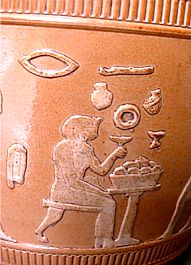 What a stylish way to have served tea in this stoneware teapot, the body of
which has many ancient Egyptian figures lined to make their offerings to
the pharaoh who is sat at a table, upon which the offerings are placed in
presentation to their Gods. This scene may not be accurate in its
depictions, but does give a flavour of the Egyptian cult. The relief moulded
detail are just as you might see in the Tombs of the Pharaoh in the Valley of
the Kings on the West bank of Luxor or in the Egyptian temples. The colour of
the Doulton ground is an ideal foil for the reliefs, being a natural stone
colour like the tomb or temple walls themselves.
What a stylish way to have served tea in this stoneware teapot, the body of
which has many ancient Egyptian figures lined to make their offerings to
the pharaoh who is sat at a table, upon which the offerings are placed in
presentation to their Gods. This scene may not be accurate in its
depictions, but does give a flavour of the Egyptian cult. The relief moulded
detail are just as you might see in the Tombs of the Pharaoh in the Valley of
the Kings on the West bank of Luxor or in the Egyptian temples. The colour of
the Doulton ground is an ideal foil for the reliefs, being a natural stone
colour like the tomb or temple walls themselves.
Each of the figures is carrying some sort of food offering, these include bread and fish in baskets upon their heads. Also, there are caged birds and Geese being carried by their wings. The detail in these mouldings is quite amazing, down to the detailed plumage of the birds.
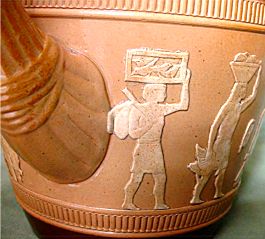
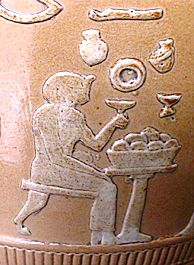
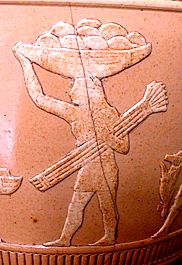
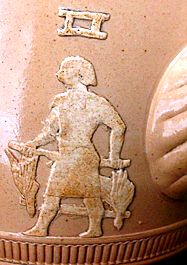
The Pharaoh is sat on a stool which has stylised Lion paw feet, as furniture of this period in Ancient Egyptian history may have had. There is rather a jumble of what might be described as Hieroglyphs, which are rather meaningless, floating around above the offering table. Usually, these Hieroglyphs would exactly describe the offerings being made to the God.
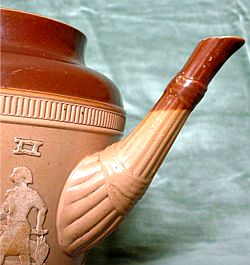
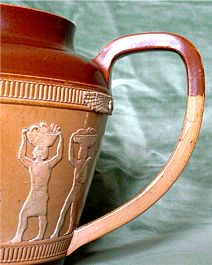 Even the spout of the teapot is moulded in the form of a bundle of tied
papyrus, bound in two places along its length. I suppose even the handle has the
resemblance of the shape of the Egyptian tool which was used during the 'opening of the
mouth ceremony' that enables the person who had died to eat and drink again in
the afterlife. This was part of the preparation for mummification of the body, where the internal
organs are removed and placed in Canopic jars in the tomb.
Even the spout of the teapot is moulded in the form of a bundle of tied
papyrus, bound in two places along its length. I suppose even the handle has the
resemblance of the shape of the Egyptian tool which was used during the 'opening of the
mouth ceremony' that enables the person who had died to eat and drink again in
the afterlife. This was part of the preparation for mummification of the body, where the internal
organs are removed and placed in Canopic jars in the tomb.
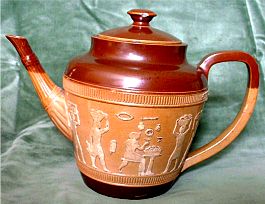
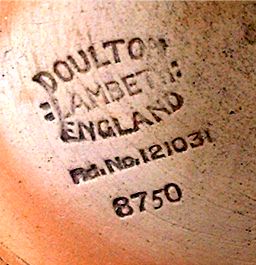 This teapot was my own Egyptian discovery, that has brought me much pleasure.
It is beautifully marked on the base with the mark of the Doulton - Lambeth
factory and includes the patent number of the design 121031. I hope that this
teapot has been of some interest to you too, it is not often that one can share
tea with the Gods!
This teapot was my own Egyptian discovery, that has brought me much pleasure.
It is beautifully marked on the base with the mark of the Doulton - Lambeth
factory and includes the patent number of the design 121031. I hope that this
teapot has been of some interest to you too, it is not often that one can share
tea with the Gods!
To review past newsletters, just follow this link:
Past newsletters.
To subscribe to this free newsletter -
Click here